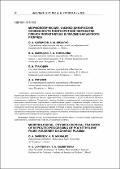| dc.contributor.author | Саркисов, О. А. | |
| dc.contributor.author | Михалко, А. М. | |
| dc.contributor.author | Лапицкая, В. А. | |
| dc.contributor.author | Кузнецова, Т. А. | |
| dc.contributor.author | Гракович, П. Н. | |
| dc.contributor.author | Рогачев, А. А. | |
| dc.coverage.spatial | Гомель | ru_RU |
| dc.date.accessioned | 2021-03-30T08:08:42Z | |
| dc.date.available | 2021-03-30T08:08:42Z | |
| dc.date.issued | 2021 | |
| dc.identifier.citation | Морфологические, физико-химические особенности многократной обработки пленок полиэтилена в плазме барьерного разряда / О. А. Саркисов [и др.] // Вестник ГГТУ им. П. О. Сухого: научно-практический журнал. — 2021. — № 1. — С. 42—52. | ru_RU |
| dc.identifier.uri | https://elib.gstu.by/handle/220612/24193 | |
| dc.description.abstract | Установлены закономерности влияния многократной обработки полиэтилена в плазме барьерного
разряда при атмосферном давлении на протекающие в поверхностных слоях структурные и морфологические изменения, определена высокая эффективность ее использования с целью достижения заданного активационного эффекта. Установлено, что при обработке в поверхностных и приповерхностных слоях образуются гидроксильные, карбонильные и карбоксильные группы, содержание которых, а также значение поверхностной энергии наиболее высоки при 4-кратной обработке. При таких режимах обработки установлено увеличение шероховатости образца в 2,8 раза, а также повышение однородности поверхности. Показано, что при увеличении кратности обработки в слоях толщиной до 300–800 нм наблюдается значительное повышение нанотвердости, которое объясняется повышением полярности поверхностных слоев, протеканием процессов молекулярной сшивки. | ru_RU |
| dc.description.abstract | The regularities of the influence of repeated processing of polyethylene in the plasma of a barrier discharge at atmospheric pressure on the structural and morphological changes occurring in the surface layers have been established, and the high efficiency of its use has been determined in order to achieve a given activation effect. It has been established that during processing in the surface and near-surface layers, hydroxyl, carbonyl and carboxyl groups are formed, the content of which, as well as the value of surface energy, are highest after 4-times processing. It has been established with such processing modes, an increase in the sample roughness by a factor of 2.8 times, as well as an increase in the surface uniformity. It has been shown that with an increase in the processing frequency in layers with a thickness of up to 300–800 nm, a significant increase in nanohardness is observed, which is explained by an increase in the polarity of the surface layers and the occurrence of molecular cross-linking processes. | |
| dc.language.iso | ru | ru_RU |
| dc.publisher | ГГТУ им. П.О. Сухого | ru_RU |
| dc.subject | Плазма | ru_RU |
| dc.subject | Диэлектрический барьерный разряд | ru_RU |
| dc.subject | Атомная силовая микроскопия | ru_RU |
| dc.subject | Шероховатость | ru_RU |
| dc.subject | Поверхностная энергия | ru_RU |
| dc.subject | Полимерный материал | ru_RU |
| dc.subject | Plasma | ru_RU |
| dc.subject | Dielectric barrier discharge | ru_RU |
| dc.subject | Atomic force microscopy | ru_RU |
| dc.subject | Roughness | ru_RU |
| dc.subject | Surface energy | ru_RU |
| dc.subject | Polymer material | ru_RU |
| dc.title | Морфологические, физико-химические особенности многократной обработки пленок полиэтилена в плазме барьерного разряда | ru_RU |
| dc.title.alternative | Morphological, physico-chemical features of repeated processing of polyethylene films in barrier discharge plasma | ru_RU |
| dc.type | Article | ru_RU |
| dc.identifier.udc | 621.315.592 | |
